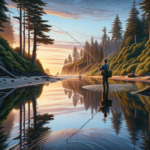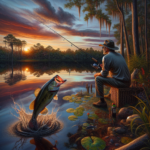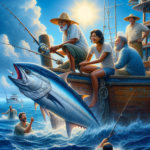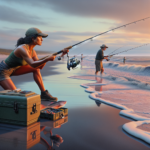Deep-Sea Fishing for Marlin in Hawaii’s Coastal Waters

Introduction
Imagine the thrill of battling a 500-pound marlin in the deep blue waters off the coast of Hawaii, the sun setting behind you, and the ocean stretching endlessly in every direction. Deep-sea fishing for marlin in Hawaii’s coastal waters is not just a sport; it’s an adventure that combines skill, patience, and a deep respect for the ocean.
This article will delve into the intricacies of deep-sea fishing for marlin in Hawaii, covering everything from the historical and cultural significance of marlin fishing in the region to the best techniques, gear, and locations. Whether you’re a seasoned angler or a novice looking to embark on your first deep-sea fishing trip, this guide will provide you with the knowledge and tips you need to make the most of your experience.
Understanding the importance of marlin fishing in Hawaii is crucial. Not only is it a popular recreational activity, but it also plays a significant role in the local economy and culture. By mastering the techniques and understanding the best practices, you can contribute to sustainable fishing practices while enjoying one of the most exhilarating fishing experiences available.
Background/Context
Historical or Cultural Significance
Marlin fishing has a rich history in Hawaii, dating back to ancient times when native Hawaiians relied on the ocean for sustenance. The marlin, known as “A’u” in Hawaiian, was revered not only for its size and strength but also for its significance in local mythology and culture. Today, marlin fishing remains a vital part of Hawaii’s fishing industry and is celebrated through various tournaments and events.
Geographical Overview
Hawaii’s coastal waters are a prime location for marlin fishing, thanks to the unique geographical features of the region. The islands are surrounded by deep ocean waters, with the continental shelf dropping off quickly, creating ideal conditions for marlin. The warm, tropical climate and nutrient-rich waters support a diverse marine ecosystem, making Hawaii one of the best places in the world for deep-sea fishing.
Key Points/Details
Fishing Techniques
Technique Overview
When it comes to marlin fishing, trolling is the most commonly used technique. This involves dragging lures or baited hooks behind a moving boat to attract marlin. Other techniques include live bait fishing and kite fishing, each with its own set of advantages and challenges.
When and Where to Use
Trolling is most effective in open waters where marlin are known to hunt. The best times for marlin fishing in Hawaii are during the summer months, from June to September, when the waters are warmest. Specific spots like the Kona Coast on the Big Island are renowned for their marlin populations.
Recommended Gear
- Rods: Heavy-duty trolling rods designed for big game fishing.
- Reels: High-capacity reels with strong drag systems, such as those from Shimano or Penn.
- Lines: Braided lines with a high pound-test rating, typically 80-130 lb test.
- Bait/Lures: Artificial lures like skirted trolling lures, or live bait such as mackerel or squid.
Species Information
Species Overview
The primary species targeted in Hawaii’s deep-sea fishing is the Pacific Blue Marlin, known for its size and fighting spirit. These fish can grow up to 1,800 pounds and are typically found in deep, warm waters. Marlin are apex predators, feeding on smaller fish and squid, and are known for their acrobatic displays when hooked.
Best Practices
To successfully catch marlin, it’s essential to use the right techniques and gear. Trolling at a speed of 7-9 knots with brightly colored lures can attract marlin. Patience is key, as marlin are known for their long, hard fights. It’s also important to practice catch and release to ensure the sustainability of marlin populations.
Location Information
Top Fishing Spots
- Kona Coast: Known as the “Marlin Capital of the World,” this area offers some of the best marlin fishing opportunities.
- Maui: The waters around Maui are also rich in marlin, with several charter services available.
- Oahu: The island’s southern coast is a popular spot for marlin fishing, with easy access from Honolulu.
Regulations and Licenses
Fishing regulations in Hawaii are designed to protect marine life and ensure sustainable fishing practices. Anglers need to obtain a fishing license, and there are specific regulations regarding the size and number of marlin that can be caught. It’s important to check the latest regulations from the Hawaii Department of Land and Natural Resources before heading out.
Seasonal Considerations
Seasonal Variations
Marlin fishing in Hawaii is best during the summer months when the waters are warmest. However, marlin can be found year-round, with peak seasons varying slightly depending on the specific location. Weather conditions can also affect fishing, with calmer seas generally providing better opportunities.
Best Times to Fish
The optimal time for marlin fishing is early morning or late afternoon when marlin are most active. During the summer months, from June to September, the chances of encountering marlin are highest.
Events and Tournaments
Event Overview
Hawaii hosts several prestigious marlin fishing tournaments, attracting anglers from around the world. The Hawaiian International Billfish Tournament (HIBT) held in Kona is one of the oldest and most renowned events, offering a chance to compete against top anglers.
Preparation Tips
Preparing for a marlin fishing tournament requires careful planning. Ensure your gear is in top condition, practice your techniques, and familiarize yourself with the tournament rules. It’s also beneficial to scout the fishing grounds beforehand and gather local knowledge on marlin behavior.
Tips and Best Practices
General Tips
- Patience: Marlin fishing can be a waiting game, so patience is crucial.
- Teamwork: Successful marlin fishing often requires a coordinated effort between the angler and the boat crew.
- Stay Hydrated: The Hawaiian sun can be intense, so keep hydrated and wear sun protection.
Avoid Common Mistakes
- Improper Gear: Using inadequate gear can result in lost fish and frustration.
- Ignoring Local Knowledge: Local guides and charter services have invaluable knowledge about marlin behavior and the best fishing spots.
- Overlooking Safety: Always prioritize safety, including wearing life jackets and being aware of weather conditions.
Advanced Techniques
- Kite Fishing: This technique involves using a kite to suspend bait on the water’s surface, attracting marlin.
- Live Bait Fishing: Using live bait can be more effective in certain conditions, requiring skill in bait handling and presentation.
Gear and Equipment Recommendations
Essential Gear
- Trolling Rods and Reels: Heavy-duty gear designed for big game fishing.
- Braided Lines: High pound-test lines for strength and durability.
- Lures and Bait: A variety of brightly colored lures and live bait options.
Optional Gear/Upgrades
- Fighting Chair: Provides support during long battles with marlin.
- Outriggers: Helps spread lines and prevent tangling.
- Fish Finder: Advanced sonar technology to locate marlin.
Where to Buy or Rent
Local tackle shops in Hawaii, such as Kona Fishing Tackle and Maui Sporting Goods, offer a wide range of gear for purchase or rent. Online stores like Bass Pro Shops and Cabela’s also provide extensive selections of marlin fishing equipment.
Safety and Conservation
Safety Tips
- Weather Awareness: Always check weather forecasts before heading out and be prepared for sudden changes.
- Life Jackets: Ensure all passengers wear life jackets, especially in rough seas.
- First Aid Kit: Carry a well-stocked first aid kit and know basic first aid procedures.
Conservation Practices
- Catch and Release: Practice catch and release to help maintain marlin populations.
- Respect Regulations: Follow local fishing regulations and size limits.
- Avoid Overfishing: Be mindful of the number of fish you catch and avoid overfishing.
Planning Your Trip
Accommodations
Hawaii offers a range of accommodations near popular fishing spots. In Kona, options include the Royal Kona Resort and the Kona Seaside Hotel. Maui offers the Grand Wailea Resort and the Maui Coast Hotel, while Oahu has the Hilton Hawaiian Village and the Outrigger Waikiki Beach Resort.
Travel Tips
When traveling to Hawaii for marlin fishing, consider flying into major airports like Kona International Airport or Honolulu International Airport. Renting a car is recommended for easy access to fishing spots. Book your accommodations and fishing charters in advance, especially during peak seasons.
Additional Activities
Hawaii offers a plethora of activities for non-fishing time. Explore the islands’ beautiful beaches, hiking trails, and cultural sites. Snorkeling, surfing, and whale watching are also popular activities that can enhance your trip.
Frequently Asked Questions (FAQs)
Do I need a fishing license to fish for marlin in Hawaii?
Yes, a fishing license is required for marlin fishing in Hawaii. You can obtain one from the Hawaii Department of Land and Natural Resources.
What is the best time of year for marlin fishing in Hawaii?
The best time for marlin fishing in Hawaii is during the summer months, from June to September, when the waters are warmest.
Can I rent fishing gear in Hawaii?
Yes, many local tackle shops and charter services offer fishing gear for rent. It’s advisable to check availability and reserve in advance.
Are there any marlin fishing tournaments in Hawaii?
Yes, Hawaii hosts several marlin fishing tournaments, including the prestigious Hawaiian International Billfish Tournament (HIBT) held in Kona.
Conclusion
Deep-sea fishing for marlin in Hawaii’s coastal waters offers an unparalleled adventure for anglers of all levels. By understanding the techniques, gear, and best practices, you can enhance your chances of success while contributing to sustainable fishing practices. Whether you’re drawn by the thrill of the catch or the beauty of Hawaii’s oceanic landscape, marlin fishing in this tropical paradise is an experience you won’t soon forget. So gear up, head out, and may the ocean reward you with the catch of a lifetime.




